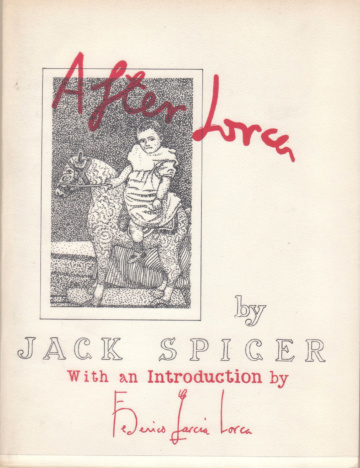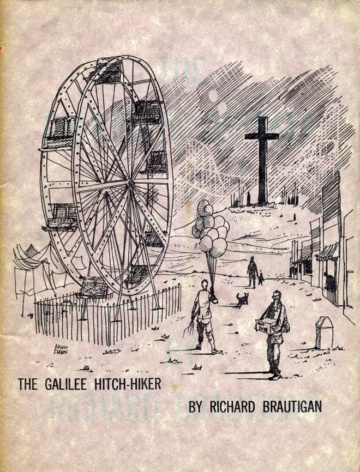White Rabbit Press
Joe Dunn and Graham Mackintosh
San Francisco and Oakland
1957–1972
Jack Spicer, After Lorca (1957). Cover by Jess (Collins).

The first book of the White Rabbit Press was Boston poet Steve Jonas’s Love, the Poem, the Sea & Other Pieces Examined, published in 1957 with a cover by San Francisco artist Jess Collins. It was followed closely by poet Jack Spicer’s breakthrough book After Lorca in the same year (“Things fit together. We knew that—it is the principle of magic.”). The press was owned by Joe Dunn, who started it to print the work of the group who surrounded Spicer at The Place in North Beach, a bar owned by Leo Krikorian, an alumnus of Black Mountain College. Dunn, who worked for Greyhound Bus Lines in San Francisco, took a secretarial course at Spicer’s insistence and learned to operate a multilith machine. He produced the first ten or eleven titles of the press at work, squeezing out time here and there.

Richard Brautigan, The Galilee Hitch-hiker (1958). Illustrated by Kenn Davis.
Among the books he produced were Denise Levertov’s 5 Poems, with a cover by Jess Collins, Richard Brautigan’s The Galilee Hitch-hiker, Helen Adam’s The Queen o’ Crow Castle, George Stanley’s The Love Root, Charles Olson’s O’Ryan 2, 4, 6, 8, 10, and Ebbe Borregaard’s The Wapitis, with a cover drawn by Robert Duncan. These pieces were all uniformly lithographed from typescripts or even manuscripts provided by the authors, and each book was sized 8½ by 6½ inches. In many ways they are perfect examples of the printing of poetry. After Joe Dunn’s relationship with methamphetamines ended in tragedy, the presswork at White Rabbit was taken over in 1962 by a close friend of Spicer’s, Graham Mackintosh, dubbed “the ruffian printer” by the elegant San Francisco pressman Robert Grabhorn. As a graduate student at Berkeley in 1961, Mackintosh had worked closely with Spicer on the Linguistic Atlas of the Pacific Coast. His first experience in printing was Spicer’s Lament for the Makers, for which he also provided the collage cover. Mackintosh, who was Robert Duncan’s favorite printer, went on to print books for Oyez and to design and print, along with Saul Marks of the Plantin Press, the first few books of the Black Sparrow Press.
It must be made clear at the start that these poems are not translations. In even the most literal of them Mr. Spicer seems to derive pleasure in inserting or substituting one or two words which completely change the mood and often the meaning of the poem as I had written it. More often he takes one of my poems and adjoins to half of it another half of his own, giving rather the effect of an unwilling centaur. (Modesty forbids me to speculate which end of the animal is mine.) Finally there are an almost equal number of poems that I did not write at all (one supposes that they must be his) executed in a somewhat fanciful imitation of my early style. The reader is given no indication which of the poems belong to which category, and I have further complicated the problem (with malice aforethought I must admit) by sending Mr. Spicer several poems written after my death which he has also translated and included here. Even the most faithful student of my work will be hard put to decide what is and what is not García Lorca as, indeed, he would if he were to look into my present resting place. The analogy is impolite, but I fear the impoliteness is deserved.”
— From the Introduction to Jack Spicer’s After Lorca by “Federico García Lorca,” outside Granada, October 1957.
White Rabbit Press books include
Adam, Helen. The Queen o’ Crow Castle. 1958. Drawings by Jess (Collins).
Alexander, James. The Jack Rabbit Poem. 1966. Drawings by Paul Alexander. Published with Open Space.
Borregaard, Ebbe. The Wapitis. 1958. Cover drawing by Robert Duncan.
Brautigan, Richard. The Galilee Hitch-hiker. 1958. Illustrated by Kenn Davis.
Brautigan, Richard. Please Plant This Book. 1968. Printed by Graham Mackintosh.
Dorbin, Sanford. The Ruby Woods. 1971. Illustrated by Chuck Miller.
Dull, Harold. Bird Poems. 1958. Illustrated by Nugent.
Duncan, Robert. As Testimony: The Poem and the Scene. 1964.
Duncan, Robert. The Cat and the Blackbird. 1967. Cover by Jess (Collins).
Duncan, Robert. Faust Foutu. 1958. Decorations by the author.
Dunn, Joe. The Better Dream House. 1968. Cover and illustrations by Jess (Collins).
Garcia, Luis. The Mechanic. 1970. Cover drawing by Walter Dusenberry.
Liddy, James. A Munster Song of Love & War. 1971.
Olson, Charles. O’Ryan 1, 2, 3, 4, 5, 6, 7, 8, 9, 10. 1965. Cover by Jess (Collins).
Olson, Charles. O’Ryan 2, 4, 6, 8, 10. 1958. Cover by Jess (Collins).
Persky, Stan. Lives of the French Symbolist Poets. 1966.
Spicer, Jack. After Lorca. 1957. Introduction by “Federico García Lorca.” Cover by Jess (Collins).
Spicer, Jack. Book of Magazine Verse. 1966.
Spicer, Jack. A Book of Music. 1969. Cover illustration by Graham Mackintosh.
Spicer, Jack. Collected Poems 1943–1946. 1981. Published with Oyez.
Spicer, Jack. The Holy Grail. 1964.
Spicer, Jack. Lament for the Makers. 1962. Cover collage by Graham Mackintosh.
Spicer, Jack. Language. 1965.
Spicer, Jack. A Redwood Forest Is Not Invisible at Night. 1965. Broadside.
Wieners, John. Reading in Bed. 1970. Broadside.
Resource
For further information on White Rabbit Press, the reader is referred to: Alastair M. Johnston, A Bibliography of the White Rabbit Press (Berkeley, CA: Poltroon Press, 1985).
